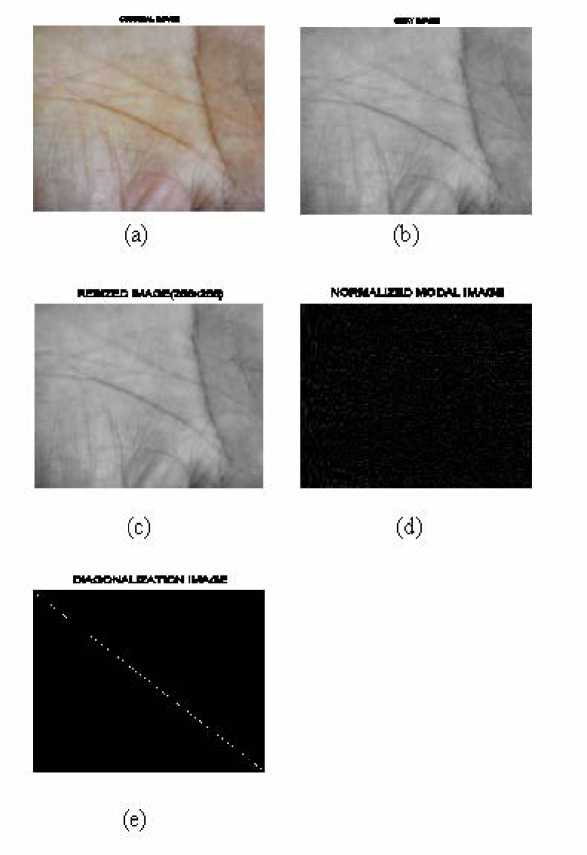IJCSI International Journal of Computer Science Issues, Vol. 2, 2009
ISSN (Online): 1694-0784
ISSN (Printed): 1694-0814
51
Therefore “n” set of eigen vectors corresponding “n”
eigen values.
Let P be the normalized modal matrix of I, the diagonal
matrix is given by
MSfnal = |(« » MSFace + β * MSPalm ) (7)
Where α and β are the weights assigned to both the traits.
The final matching score (MSFINAL) is compared against a
Where I = p D p- 1 (4)
Then
Q=CIC = C PDP C =( C P ) ( D (P-1 C) (5)
The above equation is known as a canonical form or sum
of squares form or principal axes form.
The following steps are considered for the feature
extraction:
(1) Select the text image for the input
(2) Pre-process the image (only for palm image)
(3) Determine the eigen values and eigen vectors of
the image
(4) Use the canonical for the feature extraction.
3.1 Euclidean Distance: Let an arbitrary instance X be
described by the feature vector
X = [ a 1( x ), a 2( x ).........a n ( x )] Where ar(x) denotes the
value of the rth attribute of instance x. Then the distance
between two instances xi and xj is defined to be
d(xi,xj);
n
d ( χl∙ χ , )=J∑ ( a ( X . ) - a ( Xj ))2 <6>
r=1
4 Fusion
The different biometric system can be integrated to
improve the performance of the verification system. The
following steps are performed for fusion:
(1) Given the query image as input, features are extracted
by a individual recognition.
(2) The weights α and β are calculated.
(3) Finally the sum of score technique is applied for
combining the matching score of two traits i.e. face
and palmprint. Thus the final score MNFINAL is given
by
certain threshold value to recognize the person as genuine
or an impostor.
5 Experimental Results
We evaluate the proposed multimodal system on a data set
including 720 pairs of images from 120 subjects. The
training database contains a face & palmprint images for
each individual for each subject.

IJCSI
More intriguing information
1. The name is absent2. Education Research Gender, Education and Development - A Partially Annotated and Selective Bibliography
3. Optimal Private and Public Harvesting under Spatial and Temporal Interdependence
4. Fiscal Reform and Monetary Union in West Africa
5. HACCP AND MEAT AND POULTRY INSPECTION
6. A Rational Analysis of Alternating Search and Reflection Strategies in Problem Solving
7. Three Strikes and You.re Out: Reply to Cooper and Willis
8. Evaluating the Impact of Health Programmes
9. APPLYING BIOSOLIDS: ISSUES FOR VIRGINIA AGRICULTURE
10. Philosophical Perspectives on Trustworthiness and Open-mindedness as Professional Virtues for the Practice of Nursing: Implications for he Moral Education of Nurses